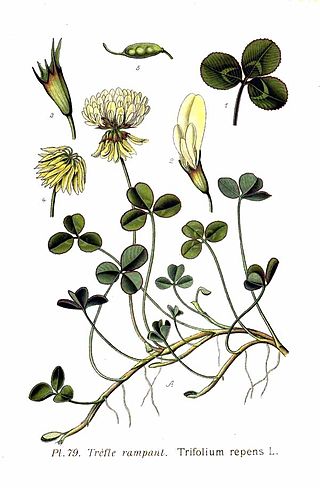
Clover, also called trefoil, are plants of the genus Trifolium, consisting of about 300 species of flowering plants in the legume family Fabaceae originating in Europe. The genus has a cosmopolitan distribution with highest diversity in the temperate Northern Hemisphere, but many species also occur in South America and Africa, including at high altitudes on mountains in the tropics. They are small annual, biennial, or short-lived perennial herbaceous plants, typically growing up to 30 centimetres (12 in) tall. The leaves are trifoliate, with stipules adnate to the leaf-stalk, and heads or dense spikes of small red, purple, white, or yellow flowers; the small, few-seeded pods are enclosed in the calyx. Other closely related genera often called clovers include Melilotus and Medicago.

Gentiana is a genus of flowering plants belonging to the gentian family (Gentianaceae), the tribe Gentianeae, and the monophyletic subtribe Gentianinae. With about 400 species, it is considered a large genus. Gentians are notable for their mostly large trumpet-shaped flowers, which are often of an intense blue hue.

Secale is a genus of the grass tribe Triticeae, which is related to barley (Hordeum) and wheat (Triticum). The genus includes cultivated species such as rye as well as weedy and wild rye species. The best-known species of the genus is the cultivated rye, S. cereale, which is grown as a grain and forage crop. Wild and weedy rye species help provide a huge gene pool that can be used for improvement of the cultivated rye.

Nonea is a genus of flowering plants in the family Boraginaceae. Sometimes known as monkswort, these are herbaceous perennials or annual plants, native to Europe, Asia and Africa.

Callirhoe is a genus of flowering plants in the mallow family, Malvaceae. Its nine species are commonly known as poppy mallows and all are native to the prairies and grasslands of North America. Of the nine species, some are annuals while others are perennial plants.

Lathyrus is a genus of flowering plants in the legume family Fabaceae, and contains approximately 160 species. Commonly known as peavines or vetchlings, they are native to temperate areas, with a breakdown of 52 species in Europe, 30 species in North America, 78 in Asia, 24 in tropical East Africa, and 24 in temperate South America. There are annual and perennial species which may be climbing or bushy. This genus has numerous sections, including Orobus, which was once a separate genus. The genus has numerous synonyms, including Pisum, the ancient Latin name for the pea.

Alchemilla is a genus of herbaceous perennial plants in the family Rosaceae, with the common name lady's mantle applied generically as well as specifically to Alchemilla mollis when referred to as a garden plant. The plant used as a herbal tea or for medicinal usage such as gynaecological disorders is Alchemilla xanthochlora or in Middle Europe the so-called common lady's mantle Alchemilla vulgaris. There are about 700 species, the majority native to cool temperate and subarctic regions of Europe and Asia, with a few species native to the mountains of Africa and the Americas.

Gentianaceae is a family of flowering plants of 103 genera and about 1600 species.

Gentianella is a plant genus in the gentian family (Gentianaceae). Plants of this genus are known commonly as dwarf gentians.

Gentianopsis holopetala is a species of flowering plant in the gentian family known by the common names Sierra fringed gentian or just "Sierra gentian"'. It is native to the Sierra Nevada and adjacent mountains in California and Nevada, in wet meadows from 6000 to 11,000 ft in elevation. This is an annual or perennial herb, growing stems which may be anywhere from a few centimeters long to nearly half a meter, and may lay along the ground or grow erect. Its small oval or spoon-shaped leaves are mostly basal but may grow sparsely further along the stem.
Gentianopsis simplex is a species of flowering plant in the gentian family known by the common name oneflower fringed gentian. It is native to the western United States, where it is most common in moist mountain habitats. This is an annual herb with erect stems which may be only a few centimeters or up to 40 centimeters in height. The leaves are lance-shaped to oval and located at the base and occasionally along the stem. Each flower is borne at the end of a peduncle which may be quite long. The flower is one to four centimeters long and light to deep bluish-purple with white staining, especially inside. The flower is somewhat trumpet shaped, with a narrowing toward the mouth. The lobes are fringed along the edges and may be in a twisted or pinwheel arrangement. The fruit is a capsule containing ridged, pointed seeds.

Polanisia is a genus of flowering plants in the family Cleomaceae. Members of the genus are commonly known as clammyweeds. Polanisia jamesii is listed as locally endangered in Minnesota, while P. dodecandra is widespread through much of North America.

The flora of the U.S. Sierra Nevada alpine zone is characterized by small, low growing, cushion and mat forming plants that can survive the harsh conditions in the high-altitude alpine zone above the timber line. These flora often occur in alpine fell-fields. The Sierra Nevada alpine zone lacks a dominant plant species that characterizes it, so may or may not be called a vegetation type. But it is found above the subalpine forest, which is the highest in a succession of recognized vegetation types at increasing elevations.
Anthopogon may refer to two different genera of plants:

Gentianopsis virgata, commonly known as lesser fringed gentian, narrow-leaved fringed gentian, or smaller fringed gentian, is a biennial herbaceous species of plant, native to eastern USA and eastern Canada.

Gentiana pannonica, the Hungarian gentian or brown gentian, is a species of flowering plant of the genus Gentiana in the family of Gentianaceae.
Gentiana pennelliana, is a rare species of flowering plant in the genus Gentiana. It is commonly known as wiregrass gentian and grows in sections of the Florida panhandle.














